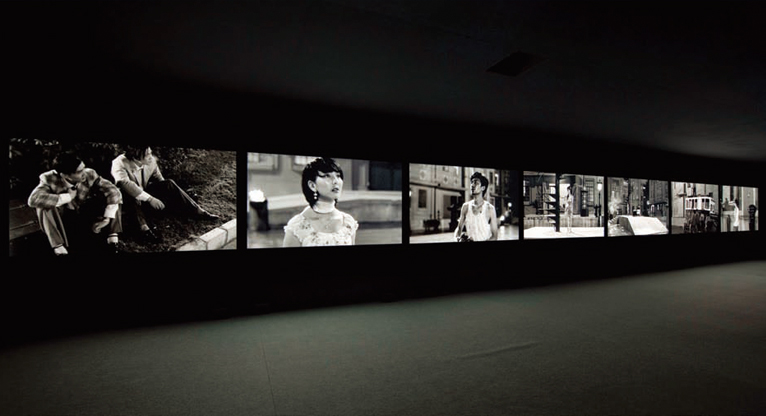YANG FUDONG: ONE HALF OF AUGUST
| April 18, 2012 | Post In LEAP 13

Yang Fudong’s film noir aesthetics have been employed in both his monumental arthouse epic Seven Intellectuals in a Bamboo Forest (2003-2007), and in his exuberant foray into advertising for Prada’s First Spring (2010). Considering this, it is difficult to know where this artist stands and for what. The answer may be clearly developed in his characters: rarely vocal, and often enclosed in atemporal frames of abstraction. This elegant sense of elusion is put to work once more in “One Half of August,” which takes Fifth Night (2010), a seven-channel installation that follows men and women wandering aimlessly across a town square, as a starting point. In the town square, here used as a stage, there is a couch, a staircase to nowhere, metal workers, and men packing a van with household items. The scene implies an evacuation verging on both post- and pre-event, duly expressed in the displacement, isolation, and confusion contorting the faces of characters caught in the middle of it all.
As always, it is not quite clear where the players are positioned and when, though one suspects northern China, maybe, circa 1936, a date that appears on a building in a fleeting frame. Perhaps it is a reference to One Day in China, May 21st, 1936, a book edited by Sherman Cochran, Mao Dun and Xie Zhenguang, in which people responded to ads placed all over China calling for a personal record of a single day— May 21, 1936. The book is a sort of literary version of Kyle Ruddick’s One Day on Earth (2011), which invited participants to film a single day, resulting in a feature-length film. These examples of disparate portraits over a specific day relate to issues of disconnection and common experience recurrent in Yang Fudong’s work. Fifth Night investigates these through characters that rarely interact with one another, and yet again, the answers are never clear.
This uneasy dissonance is furthered in “One Half of August” (2011), an eight-channel installation where courtyard exteriors and interiors are filled with white furniture and props upon which scenes from previous works— particularly from Seven Intellectuals—are projected. A visual abstraction echoing the artist’s formal background in painting, the treatment of the cinematic image as pure composition conceptually reanimates preexisting stories now further rooted in abstract, transient non-specificity. The piece acts as an ideal precursor to the final work in the exhibition triptych, Ye Jiang (The night man cometh) (2011). Composed on a single image plane— in contrast to the preceding two works— the three video installations are connected by layers of history, time, memory and subjectivity, which charge their apparent abstractions. Yet what is the intention here?
In Ye Jiang, a warrior from the annals of China’s imperial history is cast into the cold, unforgiving wilderness, while a goddess-like character, unseen, watches over him lovingly. Juxtaposed is a more modern, post-war pair: a man in a white suit, his eyes blackened and contoured by stage makeup, who follows an aloof woman in Western dress tentatively, clearly uncomfortable with the wilderness. The modern pair recalls the young bourgeois lovers who argue over issues of conformism and class-consciousness in Pier Paulo Pasolini’s Porcile while a starved medieval solider wanders the desert, having developed a cannibalistic habit out of desperation. When he is caught, tortured and sentenced to death, the soldier expresses his joy of having eaten his own father. Watching Yang Fudong’s warrior ride off on his black horse and the goddess smile one last smile at the film’s end, the notion of the missing, cannibalized father feels like a clue directed at the audience, here cast like the characters of Fifth Night: right in the middle of it all. Stephanie Bailey

